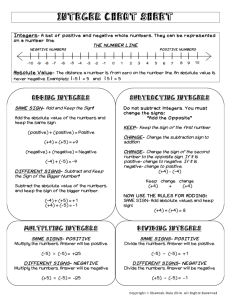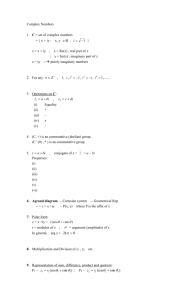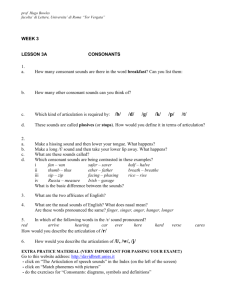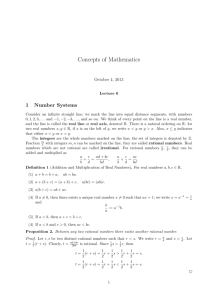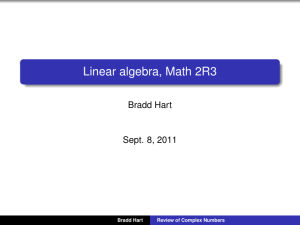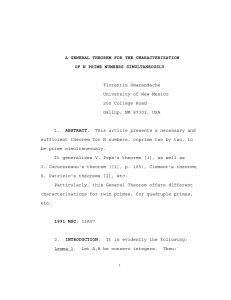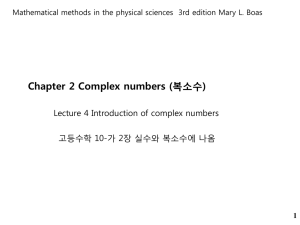Multi-restrained Stirling numbers
advertisement
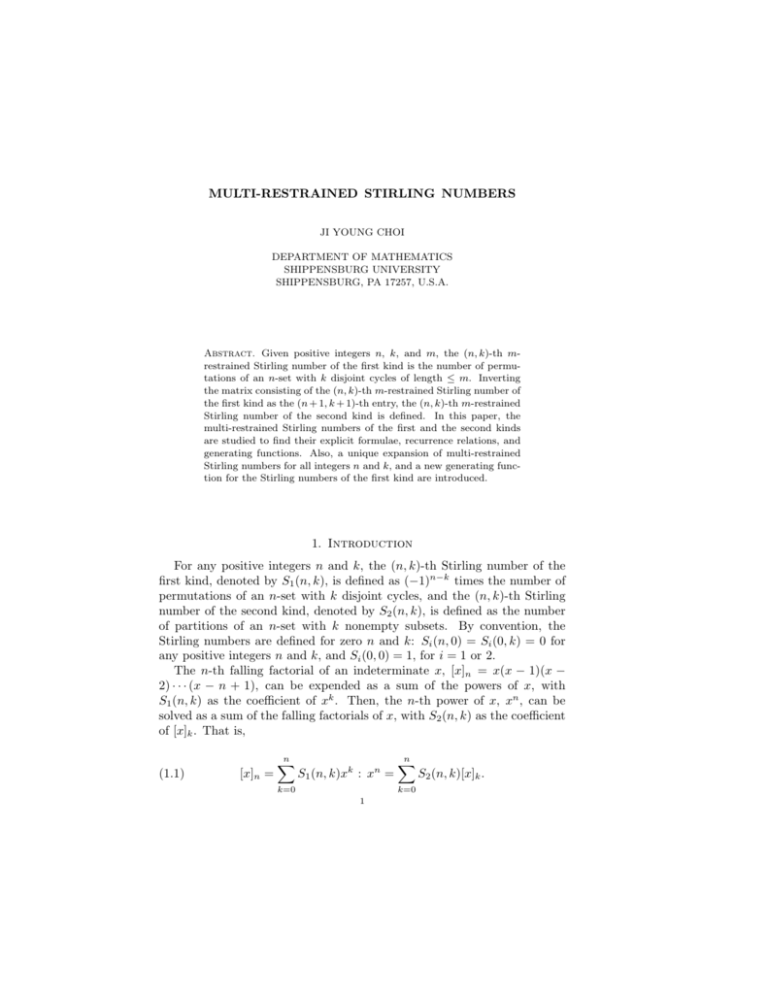
MULTI-RESTRAINED STIRLING NUMBERS
JI YOUNG CHOI
DEPARTMENT OF MATHEMATICS
SHIPPENSBURG UNIVERSITY
SHIPPENSBURG, PA 17257, U.S.A.
Abstract. Given positive integers n, k, and m, the (n, k)-th mrestrained Stirling number of the first kind is the number of permutations of an n-set with k disjoint cycles of length ≤ m. Inverting
the matrix consisting of the (n, k)-th m-restrained Stirling number of
the first kind as the (n + 1, k + 1)-th entry, the (n, k)-th m-restrained
Stirling number of the second kind is defined. In this paper, the
multi-restrained Stirling numbers of the first and the second kinds
are studied to find their explicit formulae, recurrence relations, and
generating functions. Also, a unique expansion of multi-restrained
Stirling numbers for all integers n and k, and a new generating function for the Stirling numbers of the first kind are introduced.
1. Introduction
For any positive integers n and k, the (n, k)-th Stirling number of the
first kind, denoted by S1 (n, k), is defined as (−1)n−k times the number of
permutations of an n-set with k disjoint cycles, and the (n, k)-th Stirling
number of the second kind, denoted by S2 (n, k), is defined as the number
of partitions of an n-set with k nonempty subsets. By convention, the
Stirling numbers are defined for zero n and k: Si (n, 0) = Si (0, k) = 0 for
any positive integers n and k, and Si (0, 0) = 1, for i = 1 or 2.
The n-th falling factorial of an indeterminate x, [x]n = x(x − 1)(x −
2) · · · (x − n + 1), can be expended as a sum of the powers of x, with
S1 (n, k) as the coefficient of xk . Then, the n-th power of x, xn , can be
solved as a sum of the falling factorials of x, with S2 (n, k) as the coefficient
of [x]k . That is,
(1.1)
[x]n =
n
X
k
n
S1 (n, k)x : x =
k=0
n
X
k=0
1
S2 (n, k)[x]k .
2
J.Y. CHOI
Then, the matrices consisting of Si (n, k) as the (n + 1, k + 1)-th entry for
each i = 1 and 2 are inverse to each other, i.e.
−1
[S1 (n, k)]n,k≥0 = [S2 (n, k)]n,k≥0 .
The multi-restricted numbers of the second kind are defined by restricting the size of each subset in partitions of a set. For any positive integers
m, n, and k, the (n, k)-th m-restricted number of the second kind, denoted by M2m (n, k), is defined as the number of partitions of an n-set with
k nonempty subsets, each of size ≤ m [4]. For zero n and k, the multirestricted of the second kind are also defined similarly to the the Stirling
numbers: M2m (0, 0) = 0 and M2m (n, 0) = 0 = M2m (0, k) for any positive
integers n and k.
Inverting the matrix consisting of the multi-restricted numbers of the
second kind, the multi-restricted numbers of the first kind are defined. The
(n, k)-th m-restricted number M1m (n, k) of the first kind is the (n+1, k +1)th entry in the inverse of the matrix consisting of M2m (n, k) as the (n +
1, k + 1)-entry.
By the definition, the (n, k)-th m-restricted number of the second kind
is the same as the (n, k)-th Stirling numbers of the second kind, if m ≥ n
or m > n − k. Hence, the matrix [M2m (n, k)]n,k≥0 is a lower triangular
matrix whose diagonal entries are all 1’s. So is the matrix [M1m (n, k)]n,k≥0 ,
and the (n, k)-th m-restricted number of the first kind is also the same as
the (n, k)-th Stirling number of the first kind, if m ≥ n or m > n − k.
Furthermore, the m-restricted numbers of the first kind and second kind
are the same as Stirling numbers of the first kind and second kind, if m is
large enough.
However, the m-restricted numbers of the first kind do not take alternating signs if m ≥ 3, while the Stirling numbers of the first kind do.
Moreover, the signless multi-restricted numbers of the first kind do not
count the number of permutations with a restriction on the length of each
cycle, while the multi-restricted numbers of the second kind do count the
number of partitions with a restriction on the size of each subset. That is,
the signless multi-restricted numbers of the first kind are not the signless
Stirling numbers of the first kind with the restriction on the length of each
cycle in permutations, while the multi-restricted numbers of the second
kind are the Stirling numbers of the second kind with the restriction on the
size of each subset in partitions.
In this paper, we study the so-called (signless) multi-restrained Stirling
numbers of the first kind as the number of permutations of an n-set with
k disjoint cycles, each of the length ≤ m. Section 2 includes the formal
definitions of the (signed and signless) multi-restrained Stirling numbers of
the first and second kinds, their basic properties, and their general schemes.
Section 3 includes the explicit formulae for the multi-restrained Stirling
RESTRAINED STIRLING
3
numbers of the first kind and the signless multi-restrained Stirling numbers
of the first kind. Section 4 includes two different recurrence relations for the
multi-restrained Stirling numbers of the first kind and second kind, and a
unique expansion of the multi-restrained Stirling numbers for the negative
integers n and k. Section 5 includes a generating function for the multirestrained Stirling numbers of the first kind, and a new generating function
for the Stirling numbers of the first kind.
2. Multi-restrained Stirling numbers
The (n, k)-th signless Stirling number of the first kind, denoted by C(n, k),
is the number of permutations of an n-set with k disjoint cycles, i.e.
(2.1)
C(n, k) = |S1 (n, k)|.
Since the Stirling numbers of the first kind takes alternating signs, C(n, k)
can be also expressed as C(n, k) = (−1)n−k S1 (n, k), that is
S1 (n, k) = (−1)n−k C(n, k).
(2.2)
Now, we define the number of permutations of an n-set with k disjoint
cycles restraining the length of each cycle, and obtain a new series of numbers approaching to the signless and signed Stirling numbers of the first
kind.
Definition 2.1. For all positive integers n, k, and m, the (n, k)-th signless
m-restrained Stirling number of the first kind, denoted by m C(n, k), is
defined as the number of permutations of an n-set with k disjoint cycles of
length ≤ m. For the zero n and k, m C(n, k) is defined as
(1)
(2)
m
m
C(0, 0) = 1;
C(n, k) = 0, for either n = 0 or k = 0.
Definition 2.2. For any nonnegative integers n and k and any positive
integer m, the (n, k)-th m-restrained Stirling number of the first kind, denoted by m S1 (n, k), is defined as
(2.3)
m
S1 (n, k) = (−1)n−k · m C(n, k).
4
J.Y. CHOI
The following table shows the 3-restrained Stirling numbers of the first
kind for n, k = 0, 1, 2, . . . , 7.
(2.4)
S1 (n, k) k = 0
n=0
1
1
0
2
0
3
0
4
0
5
0
6
0
7
0
1
0
1
−1
2
0
0
0
0
2
0
0
1
−3
11
−20
40
0
3
0
0
0
1
−6
35
−135
490
4
5
0
0
0
0
0
0
0
0
1
0
−10
1
85
−15
−525 175
6
0
0
0
0
0
0
1
−21
7
0
0
0
0
0
0
0
1
Since the signless restrained Stirling numbers of the first kind count the
number of permutations with the restriction on the length of each cycle,
whereas the signless Stirling numbers of the first kind count such numbers
without any restriction, the signless restrained Stirling numbers of the first
kind cannot exceed the signless Stirling numbers of the first kind. For some
n, k, and m, the restrained Stirling numbers of the first kind are even the
same as the Stirling numbers of the first kind. Especially when m is large
enough, no cycle length may exceed m.
Lemma 2.3. For any nonnegative integers n and k and any positive integer
m,
(1) |m S1 (n, k)| ≤ |S1 (n, k)|;
(2) m S1 (n, k) = S1 (n, k) if m ≥ n or m > n − k;
(3) limm→∞ m S1 (n, k) = S1 (n, k).
Proof. By Definition 2.1 and 2.2, the results are straightforward except the
case of m > n − k in (2). Suppose there exist m, n, and k such that
m > n − k and m S1 (n, k) 6= S1 (n, k). Then, |m S1 (n, k)| 6= |S1 (n, k)|, so
|m S1 (n, k)| < |S1 (n, k)| by (1). This implies there is a permutation of an
n-set with k disjoint cycles, at least one of whose lengths is greater than
m. If one cycle has length m + 1, the remaining n − (m + 1) elements
should compose k − 1 disjoint cycles, but this is impossible, because n −
(m + 1) = (n − m) − 1 < k − 1 from the condition m > n − k. Hence,
m
S1 (n, k) = S1 (n, k) if m > n − k.
¤
There is no permutation of an n-set with k disjoint cycles of length at
most m, if n < k and n > km. The identity permutation is the only permutation of an n-set having n disjoint cycles of length 1. Hence, m C(n, k) = 0
if n < k or n > km, and m C(n, n) = 1 for any positive integer m. By
Definition 2.2, we can obtain the following.
Lemma 2.4. For any nonnegative integers n and k, and any positive integer m,
RESTRAINED STIRLING
(1)
(2)
m
m
5
S1 (n, k) = 0 if n < k or n > km;
S1 (n, n) = 1.
Lemma 2.4 shows that for any fixed integer m, the matrix consisting of
S1 (n, k) as the (n + 1, k + 1)-th entry is a lower triangular matrix whose
main diagonal entries are all 1’s. This matrix is invertible. Using its inverse
matrix, we define the multi-restrained Stirling numbers of the second kind.
m
Definition 2.5. Given any positive integer m, let m S1 be the matrix consisting of m S1 (n, k) as the (n+1, k+1)-th entry for any nonnegative integers
n and k, and let m S2 be the inverse of m S1 , i.e. m S2 = (m S1 )−1 . Then,
the (n, k)-th m-restrained Stirling number of the second kind, denoted by
m
S2 (n, k), is defined to be the (n + 1, k + 1)-th entry of m S2 . That is,
[m S2 (n, k)]n,k≥0 = [m S1 (n, k)]−1
n,k≥0
(2.5)
The following table shows the 3-restrained Stirling numbers of the second
kind for n, k = 0, 1, . . . 7.
(2.6)
S2 (n, k) k = 0
n=0
1
1
0
2
0
3
0
4
0
5
0
6
0
7
0
1
0
1
1
1
−5
−65
−455
−1295
2
0
0
1
3
7
−15
−455
−4725
3
0
0
0
1
6
25
0
−1715
4
0
0
0
0
1
10
65
140
5
0
0
0
0
0
1
15
140
6
0
0
0
0
0
0
1
21
7
0
0
0
0
0
0
0
1
Since m S1 is a lower triangular matrix whose main diagonal entries are all
1’s, so is its inverse matrix m S2 .
Lemma 2.6. For any nonnegative integers n and k, and any positive integer m,
(1) m S2 (n, n) = 1;
(2) m S2 (n, k) = 0 if just one of n or k is zero;
(3) m S2 (n, k) = 0 if n < k.
Furthermore, the lower triangularity of the matrix m S1 provides the
identity between the multi-restrained Stirling numbers of the second kind
and the Stirling numbers of the second kind for some n, k, and m, as the
identity between the multi-restrained Stirling numbers of the first and the
Stirling numbers of the first kind in Lemma 2.3.
Lemma 2.7. For any positive integer m, and any nonnegative integers n
and k,
(1) m S2 (n, k) = S2 (n, k) if m ≥ n or m > n − k;
(2) limm→∞ m S2 (n, k) = S2 (n, k).
6
J.Y. CHOI
3. Explicit Formulae
The explicit formula for the signless multi-restrained numbers of the first
kind can be easily derived from the explicit formula for the signless Stirling
numbers of the first kind,
(3.1)
C(n, k) =
X
k1 + 2k2 + · · · + nkn = n
k1 + k2 + · · · + kn = k
1k1 2k2
n!
.
1 !)(k2 !) · · · (kn !)
· · · nkn (k
Since ki is just the number of the cycles of length i in each permutation,
we let ki = 0 if i > m in order to count the number of permutations of an
n-set with k disjoint cycles of length ≤ m.
Theorem 3.1. For any positive integer m and nonnegative integers n and
k, the (n, k)-th m-restrained Stirling numbers of the first kind is
(3.2)
X
n!
m
C(n, k) =
.
k
k
k
1
2
m
1 2 · · · m (k1 !)(k2 !) · · · (km !)
k1 + 2k2 + · · · + mkm = n
k1 + k2 + · · · + km = k
Proof. For any positive integer p, let 1k1 |2k2 | · · · |pkp be the partition of an
n-set with ki i-subsets where i = 1, 2, · · · , p. Since the number of cycles of
length i in an i-subset is (i − 1)!, there are ((i − 1)!)ki products of the ki
disjoint cycles of length i, where each cycle is from one of the ki i-subsets.
Hence, the number of products of the cycles, each from one of the partition
subsets in the form of 1k1 |2k2 | · · · |pkp is (0!)k1 (1!)k2 · · · ((p − 1)!)kp . Since
the number of partitions of an n-set into the subsets formed of 1k1 |2k2 | · |pkp
is
(3.3)
(1!)k1 (2!)k2
n!
· · · (p!)kp (k1 !)(k2 !) · · · (kp !)
[2], the number of permutations of an n-set with ki disjoint cycles of length
i where i = 1, 2, · · · , p is the product of (0!)k1 (1!)k2 · · · ((p−1)!)kp and (3.3),
i.e.
(3.4)
n!
1k1 2k2
· · · mkm (k
1 !)(k2 !) · · · (kp !)
To count the number of all the permutations of an n-set with k disjoint
cycles of length ≤ m, we have to add (3.4) satisfying k1 +2k2 +· · ·+mkm = n
and k1 + k2 + · · · + km = k.
¤
By Definition 2.2, the explicit formula for the multi-restrained Stirling
numbers of the first kind is as follows.
RESTRAINED STIRLING
7
Corollary 3.2. For any positive integer m and nonnegative integers n and
k, the (n, k)-th m-restrained Stirling number of the first kind is
(3.5)
X
(−1)n−k n!
m
.
S1 (n, k) =
1k1 2k2 · · · mkm (k1 !)(k2 !) · · · (km !)
k1 + 2k2 + · · · + mkm = n
k1 + k2 + · · · + km = k
4. Recurrence Relations
Consider 1 as an element of an n-set. Then, 1 is contained in exactly
one of the cycles in each permutation of an n-set. The number of cycles of
an n-set of length i containing the element 1 is
µ
¶
n−1
(4.1)
· (i − 1)! = (n − 1)(n − 2) · · · (n − i + 1),
i−1
¡
¢
because n−1
i−1 counts the choices of i − 1 elements from the n − 1 elements,
and (i − 1)! counts the number of cycles of length i using i − 1 chosen
elements together with 1. Now, there are n − i elements remaining to form
the remaining cycles that complete a permutation of the n-set. Since we
consider permutations of an n-set with k cycles of length ≤ m only, we have
to make k − 1 additional cycles of length ≤ m with the remaining n − i
elements. By adding all the cases where the element 1 belongs to a cycle of
length 1 through m, we count the number of all permutations of an n-set
with k cycles of length ≤ m. Hence,
m
X
m
(4.2)
C(n, k) =
(n − 1)(n − 2) · · · (n − i + 1) · m C(n − i, k − 1)
i=1
We can also prove this recurrence relation for the signless multi-restrained
Sitrling numbers of the first kind using the explicit formula (3.2).
Theorem 4.1. For any positive integer m and nonnegative integers n and
k,
m
X
m
(4.3)
C(n, k) =
[n − 1]i−1 m C(n − i, k − 1)
i=1
Proof.
m
C(n, k) is the sum of
n!
1k1 2k2 · · · mkm (k1 !)(k2 !) · · · (km !)
Pm
Pm
where i=1 iki = n and i=1 ki = k. Considering n! = n · (n − 1)! =
P
m
i=1 iki · (n − 1)!, (4.4) is the same as
(4.4)
m
X
i=1
(n − 1)(n − 2) · · · (n − i + 1) · (n − i)!
.
1k1 · · · iki−1 iki −1 iki+1 · · · mkm (k1 !) · · · (ki−1 )!(ki − 1)!(ki+1 ) · · · (km !)
8
J.Y. CHOI
Pm
Pm
Let pj = kj if j 6= i and pj = kj − 1 if j = i. Then, j=1 jpj = i=1 iki −
Pm
Pm
i = n − i and j=1 pj = i=1 ki − 1 = k − 1. Hence, m C(n, k) is the sum
of
m
X
(n − 1)(n − 2) · · · (n − i + 1) · (n − i)!
(4.5)
1p1 2p2 · · · mpm (p1 !)(p2 !) · · · (pm !)
i=1
Pm
Pm
where j=1 jpj = n − i and j=1 pj = k − 1. Since [n − 1]i−1 = (n −
1)(n − 2) · · · (n − i + 1) and
X
(n − i)!
m
,
C(n−i, k−1) =
1p1 2p2 · · · mpm (p1 !)(p2 !) · · · (pm !)
p1 + 2p2 + · · · + mpm = n − i
p1 + p2 + · · · + pm = k − 1
(4.3) is obtained.
¤
Definition 2.2 and Theorem 4.1 provide the recurrence relation for the
multi-restrained Stirling numbers of the first kind as follows.
Corollary 4.2. For any positive integer m and nonnegative integers n and
k,
(4.6)
m
S1 (n, k) =
m
X
(−1)i−1 [n − 1]i−1 m S1 (n − i, k − 1)
i=1
Proof. By Definition 2.2, m C(n, k) = (−1)k−n · m S1 (n, k) and m C(n−i, k −
1) = (−1)k−n+i−1 · m S1 (n − i, k − 1). Since (−1)2(k−n) = 1, (4.3) yields
(4.6).
¤
Let Sn and Sn−1 be the set of permutations of an n-set, n = {1, 2, 3, · · · , n−
1, n}, and its subset, n − 1 = {1, 2, 3, · · · , n − 1}, respectively. Then, each
permutation in Sn can be expressed as a product of a permutation σ in Sn−1
and either the 1-cycle (n) or the transposition (n a) for some a ∈ n − 1,
i.e. for any π in Sn , π can be expressed as case (1) (n)σ or case (2) (n a)σ.
To count the number of permutations of an n-set with k disjoint cycles,
we need to add the case (1) and the case (2). In the case (1), the σ ∈ Sn−1
should have k − 1 disjoint cycles, because the 1-cycle (n) is disjoint with
every cycle in σ. In the case (2), the σ ∈ Sn−1 should have k disjoint cycles,
because the transposition (n a) is not disjoint with one of the cycles in σ.
Since the length of each cycle cannot be greater than m, case (2) should
be examined more closely. Without loss of generality, let (a1 a2 · · · ai a)
be a cycle in σ. Then, (n a)(a1 a2 · · · ai a) = (a1 a2 · · · ai a n) so
the length of the product cycle is one more than the length of the cycle
before multiplying (n a) in σ. Hence, if the cycle containing the element
a in σ ∈ Sn−1 has length m, π = (n a)σ has length m + 1, that we have
to disregard. Let’s call it case (3): π ∈ Sn is expressed as a product of
RESTRAINED STIRLING
9
(n a), (a1 a2 · · · am−1 a), and any permutation of the (n − 1 − m)-set,
n − 1 − {a1 , a2 , · · · , am−1 , a}, with k − 1 cycles of length ≤ m.
The case (1) provides m C(n − 1, k − 1) and the case (2) provides (n −
1) · m C(n − 1, k), because there are n − 1 choices for the element a. The
case (3) provides (n − 1)(n − 2) · · · (n − m) · m C(n − 1 − m, k − 1), because
there are n − 1 choices for the element a and there are (n − 2) · · · (n − m)
choices for the cycle (a1 a2 · · · am−1 ). By adding the case (1) and the
case (2), and subtracting the case (3), we can have another recurrence
relation for the signless multi-restrained Stirling numbers of the first kind
as in Theorem 4.3. We can also prove this recurrence relation explicitly
using the recurrence relation in Theorem 4.1.
Theorem 4.3. For any positive integer m and nonnegative integers n and
k,
m
C(n, k) =
m
C(n − 1, k − 1) + (n − 1) · m C(n − 1, k)
− (n − 1)(n − 2) · · · (n − m) · m C(n − m − 1, k − 1)
Proof. By adding and subtracting (n − 1)(n − 2) · · · (n − m) · m C(n − m −
1, k − 1) to (4.3), we have
m
C(n, k) = m C(n − 1, k − 1)
+ {(n − 1) · m C(n − 2, k − 1)
+ ···
+ (n − 1)(n − 2) · · · (n − m + 1) · m C(n − m, k − 1)
+ (n − 1)(n − 2) · · · (n − m + 1)(n − m) · m C(n − m − 1, k − 1)}
− (n − 1)(n − 2) · · · (n − m + 1)(n − m) · m C(n − m − 1, k − 1)
Factoring (n − 1) out, the middle part {· · · } becomes
(n − 1) ·
m
X
[n − 1 − i]i−1 · m C(n − 1 − i, k − 1),
i=1
which is (n − 1) · m C(n − 1, k) by (4.3)
¤
Definition 2.2 and Theorem 4.3 provide another recurrence relation for
the multi-restrained Stirling numbers of the first kind as follows.
Corollary 4.4. For any positive integer m and nonnegative integers n and
k,
m
S1 (n, k) =
m
S1 (n − 1, k − 1) − (n − 1) · m S1 (n − 1, k)
− (−1)m (n − 1)(n − 2) · · · (n − m) · m S1 (n − m − 1, k − 1).
To obtain a recurrence relation for the multi-restrained Stirling numbers
of the second kind, we recall [3, Corollary 4.2] as follows.
10
J.Y. CHOI
Proposition 4.5. [3, Corollary 4.2] Let [a(n, k)]n,k≥0 be an infinite invertible matrix with a(0, 0) = ±1, and with only finitely many non-zero
elements in each row. Set a(n, k) = 0 if just one of n and k is negative.
Suppose that a(n, k) satisfies the graded recurrence relation
(4.7)
a(n + 1, k + 1) =
r−1
X
fi (n)a(n − i, k)
i=0
for all integers n, k with n ≥ 0. Then there is a unique extension of a(n, k)
to all integers n, k such that the relation (4.7) is always satisfied and
a(−n, −k) = (−1)n+k b(k, n)
(4.8)
for all non-negative integers n, k, where [b(n, k)]n,k∈N is the matrix inverse
to [a(n, k)]n,k∈N . Finally, we have
(4.9)
b(n − 1, k − 1) =
r−1
X
fi (k + i − 1)b(n, k + i)
i=0
for all natural numbers n and k.
Since m S1 (n, k) satisfies every condition for a(n, k) in Proposition 4.5
and the matrices [m S1 (n, k)] and [m S2 (n, k)] are inverse to each other, we
can provide a recurrence relation for the multi-restrained Stirling numbers
of the second kind.
Corollary 4.6. For any positive integer m and for any integers n and k,
(4.10)
m−1
X
m
S2 (n, k) = m S2 (n − 1, k − 1) −
(−1)i (k) · · · (k + i − 1) · m S2 (n, k + i)
i=1
Proof. The recurrence relation (4.6) can be rewritten as
m
X
m
S1 (n + 1, k + 1) =
(−1)i+1 (n)(n − 1) · · · (n + 2 − i) · m S1 (n + 1 − i, k)
i=1
=
m−1
X
(−1)i (n)(n − 1) · · · (n + 1 − i) · m S1 (n − i, k).
i=0
Hence, we can apply (4.9) of Proposition 4.5 to have
(4.11)
m
S2 (n−1, k−1) =
m−1
X
(−1)i (k+i−1)(k+i−2) · · · (k)· m S2 (n, k+i),
i=0
which can be solved for
m
S2 (n, k) as (4.10).
¤
Proposition 4.5 also provides an extension of the multi-restrained Stirling
numbers of the first kind, m S1 (n, k), and the second kind, m S2 (n, k), for
all integers n and k.
RESTRAINED STIRLING
11
Corollary 4.7. For any positive integer m and all integers n and k,
(1)
(2)
m
m
S1 (n, k) = (−1)n−k · m S2 (−k, −n)
S2 (n, k) = (−1)n−k · m S1 (−k, −n)
Proof. Applying (4.8), we have
m
S1 (−n, −k) = (−1)n−k · m S2 (k, n)
for any nonnegative integers n and k. We adjust n and k to provide (1),
and we solve (1) for m S2 (n, k) to have (2), for all integers n and k.
¤
Since both the m S1 (n, k) and m S2 (n, k) for all integers n and k are
built to satisfy the recurrence relation, the properties stated in Lemma 2.3,
Lemma 2.4, Lemma 2.6, and Lemma 2.7 can be extended for all integers n
and k. The general schemes for the m-restrained Stirling numbers of the
first kind and the second kind can be shown in the following box. Si and
m
Si represents the Stirling numbers and the m-restrained Stirling numbers
of the i-th kind, respectively, for i = 1 and 2. The blank cells represents 0.
Note that m diagonal entries of the m-restrained Stirling numbers are the
same as the Stirling numbers.
1
Si
···
Si
m
Si
m
Si
m
Si
1
Si
···
..
.
m
Si
m
Si
1
Si
..
.
Si
m
Si
1
..
.
···
Si
..
.
Si
···
1
Si
1
1
1
Si
..
.
Si
m
m
Si
Si
1
Si
..
.
Si
m
Si
1
Si
..
.
Si
..
.
..
.
1
..
.
Si
1
m-restrained Stirling numbers
Applying Corollary 4.7 to Corollary 4.4, another recurrence relation for the
multi-restrained Stirling numbers of the second kind can be obtained as
follows.
12
J.Y. CHOI
Corollary 4.8. For any positive integer m and all integers n and k,
m
S2 (n, k) =
m
S2 (n − 1, k − 1) + k · m S2 (n − 1, k)
+ (−1)m k(k + 1) · · · (k + m − 1) · m S2 (n, k + m)
Proof. Applying m S1 (n, k) = (−1)n−k · m S2 (−k, −n) to the recurrence relation in Corollary 4.4, and multiplying both sides by (−1)n−k , we have
m
S2 (−k, −n) =
m
S2 (1 − k, 1 − n) + (n − 1) · m S2 (−k, 1 − n)
− (n − 1)(n − 2) · · · (n − m) · m S2 (1 − k, 1 + m − n).
Replacing k and n with 1 − n and 1 − k respectively, we have
m
S2 (n − 1, k − 1) =
m
S2 (n, k) − k · m S2 (n − 1, k)
− (−k)(−k − 1) · · · (−k − m + 1) · m S2 (n, k + m).
Since (−k)(−k − 1) · · · (−k − m + 1) = (−1)m k(k + 1) · · · (k + m − 1), we
just need to solve for m S2 (n, k).
¤
5. Generating functions
The chain rule for the higher order differentiation of composite functions
by Faá di Bruno [1] can be modified for a special function as follows.
Proposition 5.1. For any function g(t) and for any indeterminate x, let
f (t) = (g(t))x . Then, for any positive integer n, the n-th derivative of f (t)
with respect to t is
(5.1)
¶ki
n
n µ (i)
X
X
Y
n!
g (t)
(n)
f (t) =
(g(t))x−k [x]k .
k1 !k2 ! · · · kn ! i=1
i!
k=1 k1 + 2k2 + · · · + nkn = n
k1 + k2 + · · · + kn = k
Using this modified Faá di Bruno formula (5.1), we can find a generating
function for the signless multi-restrained Stirling numbers of the first kind.
2
3
m
Theorem 5.2. For any positive integer m, let g(t) = 1+t+ t2 + t3 +· · ·+ tm ,
and for any indeterminate x, let f (t) = (g(t))x . Then, for any positive
integer n, the n-th derivative of f (t) with respect to t at t = 0 is
(5.2)
f (n) (0) =
n
X
m
C(n, k)[x]k .
k=1
Proof. Since g (j) (t) = 0 for j > m, the coefficient for [x]k of f (n) (t) in (5.1)
is
¶ki
m µ (i)
X
Y
n!
g (t)
(g(t))x−k ,
(5.3)
k1 !k2 ! · · · km ! i=1
i!
k1 + 2k2 + · · · + mkm = n
k1 + k2 + · · · + km = k
RESTRAINED STIRLING
13
for each k = 1, 2, · · · , n. Since g(0) = 1 and g (i) (0) = (i − 1)! for each
i = 1, 2, · · · , m, we have
¶ki
m µ (i)
Y
g (0)
i!
i=1
(g(0))x−k =
1
.
1k1 2k2 · · · mkm
Hence, the coefficient of [x]k in f (n) (0) for each k = 1, 2, · · · , m is
X
n!
k1 !k2 ! · · · km ! · 1k1 2k2 · · · , mkm
k1 + 2k2 + · · · + mkm = n
k1 + k2 + · · · + km = k
which is the same as
m
C(n, k) in (3.2).
¤
Since m S1 (n, k) = (−1)n−k · m C(n, k), we can also have a generating
function for the multi-restrained Stirling numbers of the first kind.
Corollary 5.3. For any positive integer m and for any indeterminate x,
3
m
2
let g(t) = 1 + t − t2 + t3 + · · · + (−1)m−1 tm and let f (t) = (g(t))x . Then,
for any positive integer n, the n-th derivative of f (t) with respect to t at
t = 0 is
f (n) (0) =
(5.4)
n
X
m
S1 (n, k)[x]k .
k=1
Proof. Since g(0) = 1 and g (i) (0) = (−1)i−1 (i − 1)!, the coefficient of [x]k
in f (n) (t), (5.3), is
X
(5.5)
k1 + 2k2 + · · · + mkm = n
k1 + k2 + · · · + km = k
¶k
m µ
Y
(−1)i−1 i
n!
·
.
k1 !k2 ! · · · km ! i=1
i
Since
m
Y
¡
(−1)i−1
¢ki
= (−1)(k1 +2k2 +···+mkm )−(k1 +k2 +···+km ) = (−1)(n−k) ,
i=1
(5.5) becomes (−1)n−k · m C(n, k) as desired.
¤
The property, limm→∞ m S1 (n, k) = S1 (n, k) for any integers n and k,
suggests a new generating function for the Stirling numbers of the first kind
as
µ
¶x
t2
t3
tm
x
lim 1 + t − + + · · · + (−1)m−1
= (1 + log(1 + t)) .
m→∞
2
3
m
14
J.Y. CHOI
Theorem 5.4. For any indeterminate x, let f (t) = (1 + log(1 + t))x .
Then, for any positive integer n, the n-th derivative of f (t) with respect
to t at t = 0 is
n
X
S1 (n, k)[x]k .
(5.6)
f (n) (0) =
k=1
Proof. Using the binomial series identity, we have
∞ µ ¶
X
x
x
f (t) = [1 + log(1 + t)] =
[log(1 + t)]k
k
=
k=0
∞
X
k=0
[log(1 + t)]k
[x]k .
k!
k
By Theorem 8.3 in p 282 of [2], we can replace [log(1+t)]
with
k!
∞
∞
X
X
tp
f (t) =
S1 (p, k) [x]k ,
p!
k=0
which is the same as
f (t) =
p=k
p
S1 (p, k) tp! :
p=k
à n
∞
X
X
n=0
P∞
!
S1 (n, k)[x]k
k=1
because S1 (n, 0) = 0 for n 6= 0.
tn
,
n!
¤
This generating function for the Stirling numbers of the first kind provides a new generating function for the signless Stirling number of the first
kind as well.
Corollary 5.5. For any indeterminate x, let f (t) = (1 − log(1 − t))x .
Then, for any positive n, the n-th derivative of f (t) with respect to t at
t = 0 is
n
X
(5.7)
f (n) (0) =
C(n, k)[x]k .
k=1
Proof. Since C(n, 0) = 0 for n 6= 0 and C(n, k) = (−1)n−k S1 (n, k), we have
à n
!
à n
!
∞
∞
X
X
X
X
tn
tn
n−k
C(n, k)[x]k
=
(−1)
S1 (n, k)[x]k
n! n=0
n!
n=0 k=1
k=0
̰
!
∞
X X
tn
=
(−1)n−k S1 (n, k)
[x]k .
n!
n=0
k=0
RESTRAINED STIRLING
15
Since (−1)n−k S1 (n, k)tn = (−1)k S1 (n, k)(−t)n ,
̰
!
∞
X
X
tn
(−t)n
n−k
k
(−1)
S1 (n, k) = (−1)
S1 (n, k)
n!
n!
n=0
n=0
¶
µ
[− log(1 − t)]k
[− log(1 − t)]k
= (−1)k
(−1)k =
,
k!
k!
by Corollary 8.1 in p 283 [2]. Hence,
à n
!
∞
∞
X
X
X
[− log(1 − t)]k
tn
=
[x]k
C(n, k)[x]k
n!
k!
n=0 k=1
k=0
∞ µ ¶
X
x
x
=
[− log(1 − t)]k = (1 − log(1 − t)) .
k
k=0
¤
References
[1] Faá di Bruno, C. F. Note sure une nouvelle formule du calcul differentiel, Quart.
J. math., 1, 359–360
[2] C. A. Charalambides, Enumerative Combinatorics, Chapman & Hall/CRC, 2002.
[3] J.Y. Choi, L. Long, S.-H. Ng, and J.D.H. Smith Reciprocity for Stirling and multirestricted numbers, J. Comb. Th., Ser. A, 113 (2006), 1050–1060
[4] J.Y. Choi and J.D.H. Smith, On the combinatorics of multi-restricted numbers, Ars
Combinatoria, 75 (2005), 44–63.
E-mail address: jychoi@ship.edu
